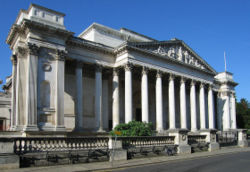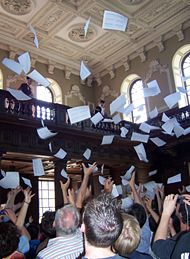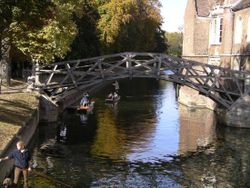University of Cambridge
2008/9 Schools Wikipedia Selection. Related subjects: Education
| University of Cambridge | |
|---|---|
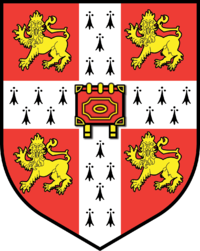 |
|
|
Latin: Universitas Cantabrigiensis |
|
| Motto: | Hinc lucem et pocula sacra Literal translation: “From here, light and sacred draughts”. Non-literal: “From this place, we gain enlightenment and precious knowledge”. |
| Established: | c. 1209 |
| Type: | Public |
| Endowment: | £4.1 billion (2006, incl. colleges) |
| Chancellor: | HRH The Duke of Edinburgh |
| Vice-Chancellor: | Professor Alison Richard |
| Students: | 25,465 |
| Undergraduates: | 16,295 |
| Postgraduates: | 9,170 |
| Location: | Cambridge, England |
| Colours: | Cambridge Blue |
| Athletics: | The Sporting Blue |
| Affiliations: | Russell Group Coimbra Group EUA LERU IARU |
| Website: | http://www.cam.ac.uk |
The University of Cambridge (often Cambridge University), located in Cambridge, England, is the second-oldest university in the English-speaking world and has a reputation as one of the world's most prestigious universities.
The University grew out of an association of scholars in the city of Cambridge that was formed, early records suggest, in 1209 by scholars leaving Oxford after a dispute with local townsfolk there.
The universities of Oxford and Cambridge are often jointly referred to as Oxbridge. In addition to cultural and practical associations as a historic part of English society, the two universities also have a long history of rivalry with each other.
Cantabrigian is the formal adjective meaning "of Cambridge University" which is also used as a term for the university's members (abbreviated as Cantab. in post-nominal letters for alumni).
Organisation
Cambridge is a collegiate university, with its main functions divided between the central departments of the university and 31 colleges. In general, the departments perform research and provide centralised lectures to students, while the colleges are responsible for the domestic arrangements and welfare of undergraduate students, graduate students, post-doctoral researches and some University staff. The colleges also provide most of the small group teaching for undergraduates, referred to as supervisions. The 31 colleges are technically institutions independent of the university itself and enjoy considerable autonomy. For example, colleges decide which students they are to admit, and appoint their own fellows (senior members). In Cambridge, “the university” often refers to the University as opposed to the colleges.
Central administration
The current Chancellor of the university is the Duke of Edinburgh. The current Vice-Chancellor is Professor Alison Richard. The office of Chancellor, which is held for life, is mainly ceremonial, while the Vice-Chancellor is de facto the prinicipal academic and administrative officer. The University's internal governance is carried out almost entirely by its own members, with little external representation on its governing bodies with the exception of the Audit Committee. The governing body of the University is the Regent House (comprised of resident senior members of the University and the Colleges, together with the Chancellor, the High Steward, the Deputy High Steward, and the Commissary). The University Council is the principal executive and policy-making body of the University, and is subject to Regent House. Since January 2005, the membership of the Council has included two external members. The General Board of the Faculties is responsible, subject to the Regent House and to the responsibilities of the Council, for the academic and educational policy of the University. The Cambridge Reporter Regent House and The Senate consists of all holders of the MA degree or higher degrees. It elects the Chancellor and the High Steward; until their abolition in 1950, it elected Members to the House of Commons for the Cambridge University constituency, but otherwise it has not had a major role since 1926.
Colleges
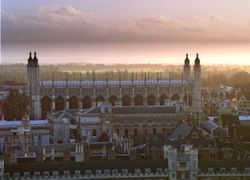
The University of Cambridge currently has 31 colleges, of which three admit only women ( New Hall, Newnham and Lucy Cavendish). The remaining 28 are mixed, Magdalene being the last all-male college to begin admitting women in 1988. Two colleges admit only postgraduates ( Clare Hall and Darwin), and four more admit mainly mature students or graduate students ( Hughes Hall, Lucy Cavendish, St Edmund’s and Wolfson). The other 25 colleges admit both undergraduate and postgraduate students. Colleges are not required to admit students in all subjects, with some colleges choosing not to offer subjects such as architecture or history of art, but most offer close to the complete range. Some colleges maintain a bias towards certain subjects, for example with Churchill leaning towards the sciences and engineering. Costs to students (accommodation and food prices) vary considerably from college to college.
There are several historical colleges which no longer exist, such as King’s Hall (founded in 1317) and Michaelhouse which were combined by King Henry VIII to establish Trinity in 1546, and Gonville Hall which was founded in 1348 and then re-founded in 1557 as Gonville & Caius.
There are also several theological colleges in Cambridge, (for example Westminster College and Ridley Hall Theological College) that are loosely affiliated with the university through the Cambridge Theological Federation.
Research and teaching
Cambridge University has research departments and teaching faculties in most academic disciplines. Cambridge tends to have a slight bias towards scientific subjects, but it also has a number of strong humanities and social science faculties. Academic staff (and often graduate students for the larger subjects) teach the undergraduates in both lectures and personal supervisions in which a ratio of one teacher to between one and three students is usually maintained. This pedagogical system is often cited as being unique to the Universities of Cambridge and Oxford (where “supervisions” are known as “tutorials”) – similar practices can be found elsewhere, though not on the Oxbridge scale.
All research and lectures are conducted by University Departments. The colleges are in charge of giving or arranging most supervisions, student accommodation, and funding most extracurricular activities. During the 1990s Cambridge added a substantial number of new specialist research laboratories on several University sites around the city, and major expansion continues on a number of sites .
Cambridge is a member of the Russell Group, a network of research-led British universities; the Coimbra Group, an association of leading European universities; the League of European Research Universities; and the International Alliance of Research Universities. It is also considered part of the "Golden Triangle", a geographical concentration of UK university research.
Finances
In 2006, it was reported that approximately one third of Cambridge’s income comes from UK government funding for teaching and research, with another third coming from other research grants. Endowment income contributes around 6%.
In late 2006, the total financial endowment of the university and the colleges was estimated at £4.1 billion: £1.2 billion tied directly to the university, £2.9 billion to the colleges – this endowment is arguably the largest in Europe. Each college is an independent charitable institution with its own endowment, separate from that of the central university endowment.
If ranked on a US university endowment table using figures reported in 2006, Cambridge would rank sixth or seventh (depending on whether one includes the University of Texas System – which incorporates nine full scale universities and six health institutions), or fourth in a ranking compared with only the eight Ivy League institutions.
In 2005, the Cambridge 800th Anniversary Campaign was launched, aimed at raising £1 billion by 2012 – the first US-style university fundraising campaign in Europe. £300 million of funds had already been secured in the pre-launch period.
Reputation
According to UCAS, Cambridge and Oxford are the most academically selective universities in the United Kingdom — there is a special national admissions process which sets Oxbridge apart from other British universities. To apply to Cambridge, an additional application form (CAF) needs to be submitted, in addition to the UCAS application. This includes a form requesting your UMS scores for every module you have taken.
In the most recent British Government Research Assessment Exercise in 2001, Cambridge was ranked first in the country. In 2005, it was reported that Cambridge produces more PhDs per year than any other British university (over 30% more than second placed Oxford). In 2006, a Thomson Scientific study showed that Cambridge has the highest research paper output of any British university, and is also the top research producer (as assessed by total paper citation count) in 10 out of 21 major British research fields analysed ( Imperial College came second, leading in 3 fields). Another study published the same year by Evidence showed that Cambridge won a larger proportion (6.6%) of total British research grants and contracts than any other university (coming first in three out of four broad discipline fields).
Historically, the university has produced a significant proportion of Britain’s prominent scientists, writers and politicians. Officially, affiliates of Cambridge University have won a total of 82 Nobel Prizes, more than any other university in the world and more than any country in the world except the United Kingdom and the United States. Seventy of these Nobel Laureates also attended Cambridge as undergraduate or graduate students. In addition, there are at least six Nobel Laureates who taught or researched for an extended period at Cambridge who have not been recognised by the official total.
In addition to a long distinguished tradition in the humanities and the arts, the University of Cambridge is especially known for producing prominent scientists and mathematicians. This distinguished list includes Isaac Newton, Charles Darwin, William Harvey, Paul Dirac, J. J. Thomson, Ernest Rutherford, Jane Goodall, James Clerk Maxwell, Francis Crick, Alan Turing, Stephen Hawking, and Fred Sanger.
The university is also closely linked with the development of the high-tech business cluster in and around Cambridge, which forms the area known as Silicon Fen or sometimes the “Cambridge Phenomenon”. In 2004, it was reported that Silicon Fen was the second largest venture capital market in the world, after Silicon Valley. Estimates reported in February 2006 suggest that there were about 250 active startup companies directly linked with the university, worth around US$6 billion.
League Table Rankings
| 2008 | 2007 | 2006 | 2005 | |
|---|---|---|---|---|
| Times Good University Guide | 2nd | 2nd | 2nd | |
| Guardian University Guide | 2nd | 1st | 2nd | |
| Sunday Times University Guide | 1st | 1st | 1st | |
| Daily Telegraph | 1st |
| 2007 | 2006 | 2005 | 2004 | 2003 | |
|---|---|---|---|---|---|
| THES - QS World University Rankings | 2nd | 2nd | 3rd | ||
| Academic Ranking of World Universities | 4th | 2nd | 2nd | 3rd | 5th |
The THES - QS rankings also placed Cambridge first in the international academic reputation peer review, first in the natural sciences, first in biomedicine, first in the arts & humanities, fourth in the social sciences, and sixth in technology. A 2006 Newsweek ranking which combined elements of the Jiao Tong survey with other factors that purportedly evaluated an institution's global "openness and diversity" suggested that Cambridge was ranked 6th in the world overall. A 2007 ranking by Webometrics which only attempts to evaluate the internet publication activities of universities, placed Cambridge at 19th in the world overall. In all these surveys, Cambridge was the highest ranked non-US institution. (Note that all university rankings are subject to controversy about their methodology, and that the THES - QS and Jiao Tong tables are the only annual comprehensive international rankings by academic specialists available).
History
Early history
Roger of Wendover wrote that Cambridge University could trace its origins to a crime committed in 1209. Although not always a reliable source, the detail given in his contemporaneous writings lends them credence. Two Oxford scholars were convicted of the murder or manslaughter of a woman and were hanged by the town authorities with the assent of the King. In protest at the hanging, the University of Oxford went into voluntary suspension, and scholars migrated to a number of other locations, including the pre-existing school at Cambridge (Cambridge had been recorded as a “school” rather than university when John Grim held the office of Master there in 1201). These post-graduate researchers from Oxford started Cambridge’s life as a university in 1209. Cambridge’s status as a university is further confirmed by a decree in 1233 from Pope Gregory IX which awarded the ius non trahi extra (a form of legal protection) to the chancellor and universitas of scholars at Cambridge. After Cambridge was described as a studium generale in a letter by Pope Nicholas IV in 1290, and confirmed as such in a bull by Pope John XXII in 1318, it became common for researchers from other European medieval universities to come and visit Cambridge to study or to give lecture courses.
Foundation of the Colleges
Cambridge’s colleges were originally an incidental feature of the system. No college is as old as the university itself. The colleges were endowed fellowships of scholars. There were also institutions without endowments, called hostels. The hostels were gradually absorbed by the colleges over the centuries, but they have left some indicators of their time, such as the name of Garrett Hostel Lane.
Hugh Balsham, Bishop of Ely, founded Peterhouse in 1284, Cambridge’s first college. Many colleges were founded during the fourteenth and fifteenth centuries, but colleges continued to be established throughout the centuries to modern times, although there was a gap of 204 years between the founding of Sidney Sussex in 1596 and Downing in 1800. The most recent college established is Robinson, built in the late 1970s.
In medieval times, colleges were founded so that their students would pray for the souls of the founders. For that reason they were often associated with chapels or abbeys. A change in the colleges’ focus occurred in 1536 with the dissolution of the monasteries. King Henry VIII ordered the university to disband its Faculty of Canon Law and to stop teaching “ scholastic philosophy”. In response, colleges changed their curricula away from canon law and towards the classics, the Bible, and mathematics.
Mathematics
From the time of Isaac Newton in the later 17th century until the mid-19th century, the university maintained a strong emphasis on mathematics. Study of this subject was compulsory for graduation, and students were required to take an exam for the Bachelor of Arts degree, the main first degree at Cambridge in both arts and science subjects. This exam is known as a Tripos.
Students awarded first-class honours after completing the mathematics Tripos were named wranglers. The Cambridge Mathematical Tripos was competitive and helped produce some of the most famous names in British science, including James Clerk Maxwell, Lord Kelvin, and Lord Rayleigh. However, some famous students, such as G. H. Hardy, disliked the system, feeling that people were too interested in accumulating marks in exams and not interested in the subject itself.
Although diversified in its research and teaching interests, Cambridge today maintains its strength in mathematics. The Isaac Newton Institute, part of the university, is widely regarded as the UK’s national research institute for mathematics and theoretical physics. Cambridge alumni have won eight Fields Medals and one Abel Prize for mathematics. The University also runs a special Certificate of Advanced Studies in Mathematics course.
Contributions to the advancement of science
Many of the most important scientific discoveries and revolutions were made by Cambridge alumni. These include:
- Understanding the scientific method, by Francis Bacon
- The laws of motion, by Sir Isaac Newton
- The unification of electromagnetism, by James Clerk Maxwell
- The discovery of hydrogen, by Henry Cavendish
- Evolution by natural selection, by Charles Darwin
- The Turing machine, the basis of modern computers, by Alan Turing
- The structure of DNA, by Francis Crick and James D. Watson
Women’s education
Originally all students were male. The first colleges for women were Girton College (founded by Emily Davies) in 1869 and Newnham College in 1872. The first women students were examined in 1882 but attempts to make women full members of the university did not succeed until 1947. Although Cambridge did not give degrees to women until this date women were in fact allowed to study courses, sit examinations, and have their results recorded from the nineteenth century onwards. In the twentieth century women could be given a “titular degree”; although they were not denied recognised qualifications, without a full degree they were excluded from the governing of the university. Since students must belong to a college, and since established colleges remained closed to women, women found admissions restricted to colleges established only for women. All of the men’s colleges began to admit women between 1960 and 1988. One women’s college, Girton, also began to admit men, but the other women’s colleges did not follow suit. In the academic year 2004–5, the university’s student gender ratio, including post-graduates, was male 52%: female 48% (Source: Cambridge University Reporter, ).
Admissions
The application system to Cambridge and Oxford often involves additional requirements, and in the UK includes the Cambridge Admissions Form. Candidates are also typically called to face-to-face interviews.
How applicants perform in the interview process best determines which candidates are accepted. Most applicants are expected to be predicted at least three A-grade A-level qualifications relevant to their chosen undergraduate course, or equivalent overseas qualifications. Due to a very high proportion receiving the highest school grades from the private and grammar schools, this makes the interview process crucial at distinguishing the most able candidates and important in trying to recruit from comprehensive schools. In 2005, 5,325 students were rejected who went on to get 3 A levels or more at grade A, representing about 60% of all applicants rejected. The interview is performed by College Fellows, who evaluate candidates on unexamined factors such as potential for original thinking and creativity. For exceptional candidates, a Matriculation Offer is sometimes offered, requiring only two A-levels at grade E or above - Christ's College is unusual in making this offer to about one-third of successful candidates.
In recent years, admissions tutors in certain subjects have required applicants to sit the more difficult STEP papers, tuition for which is not normally provided by British schools outside the private or independent sector, in addition to achieving top grades in their A-levels or International Baccalaureate diplomas. For example, Peterhouse requires 1 and 2 or better in STEP as well as A grades at A-levels including A-level Mathematics and Further Mathematics in order to be considered for entry for the Mathematical Tripos. Between one-half and two-thirds of those who apply with the required grades are given offers of a place.
Public debate in the United Kingdom continues over whether admissions processes at Oxford and Cambridge are entirely merit based and fair; whether enough students from state schools are encouraged to apply to Cambridge; and whether these students succeed in gaining entry. Almost half of all successful applicants come from independent schools. However, the average qualifications for successful applicants from state schools are slightly lower than the average qualification of successful applicants from private schools. Critics have argued that the lack of state school applicants with the required grades applying to Cambridge and Oxford has had a negative impact on Oxbridge’s reputation for many years, and the University has encouraged pupils from state schools to apply for Cambridge to help redress the imbalance. Others counter that government pressure to increase state school admissions constitutes inappropriate social engineering. The proportion of undergraduates drawn from independent schools has dropped over the years, and such applicants now form only a significant minority (42.1%) of the intake. In 2005, 32% of the 3599 applicants from independent schools were admitted to Cambridge, as opposed to 24% of the 6674 applications from state schools.
Graduate admission is first decided by the faculty or department relating to the applicant’s subject. This effectively guarantees admission to a college - though not necessarily the applicant’s preferred choice.
Sport and other extracurricular activities
Cambridge maintains a long tradition of student participation in sport and recreation. Rowing is a particularly popular sport at Cambridge, and there are competitions between colleges, notably the bumps races, and against Oxford, the Boat Race. There are also Varsity matches against Oxford in many other sports, ranging from rugby, see Cambridge University RUFC, and cricket, to chess and tiddlywinks. Athletes representing the university in certain sports entitle them to apply for a Cambridge Blue at the discretion of the Blues Committee, consisting of the captains of the thirteen most prestigious sports. There is also the self-described “unashamedly elite” Hawks’ Club, which is for men only, whose membership is usually restricted to Cambridge Full Blues and Half Blues.
The Cambridge Union serves as a focus for debating. Drama societies notably include the Amateur Dramatic Club (ADC) and the comedy club Footlights, which are known for producing well-known showbusiness personalities. Student newspapers include the long-established Varsity and its younger rival, The Cambridge Student. The student-run radio station, CUR1350, promotes broadcast journalism.
Myths, legends and traditions
There are many popular myths associated with the University of Cambridge:
One famous myth relates to Queens’ College’s so-called Mathematical Bridge (pictured right). Supposedly constructed by Sir Isaac Newton, it reportedly held itself together without any bolts or screws. Legend has it inquisitive students took it apart and were then unable to reassemble it without bolts. However, the bridge was erected 22 years after Newton’s death. This myth may have arisen from the fact that earlier versions of the bridge used iron pins and screws at the joints, whereas the current bridge uses more visible nuts and bolts.
Another famous myth involves Clare Bridge, currently the oldest bridge, which is attached to Clare College. Spherical stone ornaments adorn this bridge. One of these has a quarter sphere wedge removed from the back. This is a feature pointed out on almost all tours over the bridge. Various myths are associated with this sphere. See Cambridge legends.
A discontinued tradition is that of the wooden spoon, the ‘prize’ awarded to the student with the lowest passing grade in the final examinations of the Mathematical Tripos. The last of these spoons was awarded in 1909 to Cuthbert Lempriere Holthouse, an oarsman of the Lady Margaret Boat Club of St John’s College. It was over one metre in length and had an oar blade for a handle. It can now be seen outside the Senior Combination Room of St John's. Since 1909, results were published alphabetically within class rather than score order. This made it harder to ascertain who the winner of the spoon was (unless there was only one person in the third class), and so the practice was abandoned.
On the other hand, the legend of the Austin 7 delivery van that ended up on the apex of the Senate House is no myth at all. The Caius College website recounts in detail how this vehicle “went up in the world”.
Each Christmas Eve, BBC radio and television broadcasts The Festival of Nine Lessons and Carols by the Choir of King's College, Cambridge. The radio broadcast has been a national Christmas tradition since it was first transmitted in 1928 (though the festival has existed since 1918). The radio broadcast is carried worldwide by the BBC World Service and is also syndicated to hundreds of radio stations in the USA. The first television broadcast of the festival was in 1954.
Selected notable members
|
|
Cambridge University in literature and popular culture
Fiction
- Chaucer’s The Reeve’s Tale takes place at Soler Halle. It is believed that this refers to King’s Hall, which later became part of Trinity College.
- The Glittering Prizes (1976 TV drama) and Oxbridge Blues (1984 TV drama) by Frederic Raphael.
- The Longest Journey and Maurice by E.M. Forster
- Still Life by A. S. Byatt
- Chariots of Fire, 1981 film
- Peter's Friends, 1992 film
- The Masters and The Affair by C. P. Snow (features an unnamed fictional college, partly based on his own college, Christ’s)
- Porterhouse Blue and its sequel Grantchester Grind by Tom Sharpe feature Porterhouse, a fictional Cambridge College.
- Darkness at Pemberley by T. H. White
- All Sorts and Conditions of Men by Sir Walter Besant
- High Table, Lower Orders BBC Radio comedy serial broadcast in 2005 and 2006 set in a fictional college.
- The Matthew Bartholomew Chronicles, a series of murder mysteries, by Susanna Gregory
- Avenging Angel, a murder mystery by the philosopher Kwame Anthony Appiah
- Eskimo Day is a 1996 BBC TV drama, written by Jack Rosenthal, and starring Maureen Lipman, Tom Wilkinson, and Alec Guinness, about the relationship between parents and teenagers during an admissions interview day at Queens’ College. There was also a 1997 sequel, Cold Enough for Snow.
- The final episode of Star Trek: The Next Generation, ( All Good Things…) features the android character Data as Lucasian Professor of Mathematics in his Cambridge college rooms. An establishing location shot shows a futuristic version of the Cambridge University skyline around the year 2395.
- Civilization - a classic turn-based strategy video game by Sid Meier features “Isaac Newton’s College” as a Wonder of the World. This could be a reference to Cambridge University as a whole or to Trinity College specifically. The video accompanying the wonder in Civilization II however, erroneously shows the University of Oxford.
- In many novels and plays by Thomas Bernhard, Cambridge (Geistesnest) is the refuge of a Geistesmensch escaping from Austria
- In Tom Stoppard's 2006 play Rock 'n Roll, Cambridge University is a key setting.
- In Bob Fosse's 1972 film Cabaret, one of the central characters, Englishman Brian Roberts is a King's College student finishing his German studies in Berlin.
- In Virginia Woolf's Jacob's Room, the protagonist Jacob Flanders attends Cambridge.
- In Charles Dicken's 'A Tale of Two Cities', Charles Darnay tutors Cambridge undergraduates in French language and literature.
- Alan Bennett's 2004 play The History Boys and the 2006 film centre around students in the north of England preparing for the old entrance exams at Cambridge and Oxford in 1983.
See also the list of Fictional Cambridge Colleges
Non-fiction
- A concise history of the University of Cambridge, by Elisabeth Leedham-Green, Cambridge University Press, 1996, ISBN 0-521-43978-7, ISBN 978-0-521-43978-7
- A history of the University of Cambridge, by Christopher N.L. Brooke, Cambridge University Press, 4 volumes, 1988–2004, ISBN 0-521-32882-9, ISBN 0-521-35059-X, ISBN 0-521-35060-3, ISBN 0-521-34350-X
- Bedders, bulldogs and bedells: a Cambridge glossary, by Frank Stubbings, Cambridge 1995 ISBN 0-521-47978-9
- Japanese Students at Cambridge University in the Meiji Era, 1868–1912: Pioneers for the Modernization of Japan , by Noboru Koyama, translated by Ian Ruxton , Lulu Press, September 2004, ISBN 1-4116-1256-6. This book includes information about the wooden spoon and the university in the 19th century as well as the Japanese students.
- Teaching and Learning in 19th century Cambridge, by J. Smith and C. Stray (ed.), Boydell Press, 2001 ISBN 0-85115-783-1
- The Architectural History of the University of Cambridge and of the Colleges of Cambridge and Eton, Robert Willis, Edited by John Willis Clark, 1988. Three volume set, Cambridge University Press ISBN 0-521-35851-5
- The Cambridge Apostles: A History of Cambridge University’s Elite Intellectual Secret Society, by Richard Deacon, Cassell, 1985, ISBN 0-947728-13-9
University activities
History and traditions
- Cambridge University Professorships, Chancellors and Vice-Chancellors
- Cambridge University (UK Parliament constituency)
- Registrary
- List of Oxbridge sister colleges
- Oxbridge scarf colours
- Academic dress of the University of Cambridge
- Formal Hall (formal evening meals)

